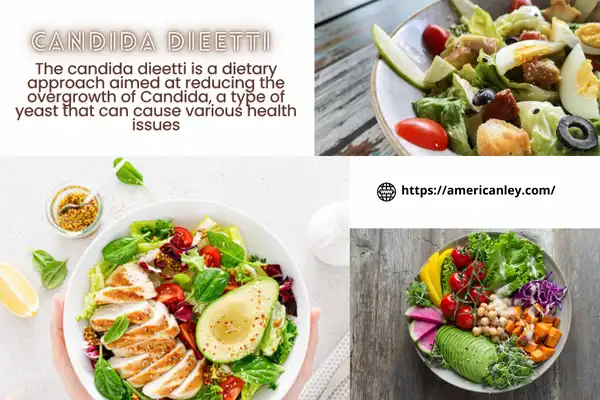What is Candida Dieetti?
The candida dieetti is a dietary approach aimed at reducing the overgrowth of Candida, a type of yeast that can cause various health issues. It emphasizes a low-sugar, anti-inflammatory eating plan.It aims to promote good gut health by eliminating the sugars that can contribute to candida overgrowth in the body. The diet includes a variety of non-starchy vegetables, low-sugar fruits, non-glutenous grains, some dairy products, and fermented foods to support a healthy balance of microorganisms in the body.
Common symptoms of candida overgrowth
- Digestive issues: bloating, gas, constipation, diarrhea, abdominal pain, and indigestion.
- Skin and nail issues: skin rashes, eczema, acne, hives, nail fungus, and athlete’s foot.
- Fatigue and low energy: tired or run down, even after adequate rest.
- Brain fog and difficulty concentrating: feeling mentally sluggish, forgetful, or having trouble focusing.
- Mood swings and irritability: feeling anxious, depressed, or irritable.
- Sugar cravings: experiencing intense cravings for sugary or carb-rich foods.
- Vaginal infections : recurring yeast infections, UTIs, and bacterial vaginosis.
- Oral thrush: white or yellowish coating on the tongue or inside of the mouth.
- Joint pain: experiencing stiffness, swelling, and pain in the joints.
- Chronic sinus infections: recurring sinus infections, congestion, and post-nasal drip.
Causes
Overgrowth can be caused by various factors, including antibiotic use, a diet high in sugar and refined carbohydrates, a weakened immune system, hormonal imbalances, chronic stress, and digestive issues like IBS, IBD, and leaky gut syndrome.
Food to Take
Non-starchy vegetables: broccoli, spinach, kale, zucchini, cucumber, cauliflower, asparagus, Brussels sprouts, cabbage, and others.
Low-sugar fruits: berries, grapefruit, green apple, lemon, lime, and others.
Non-glutenous grains: quinoa, brown rice, oats, and others. Lean proteins: chicken, fish, turkey, eggs, and others.
Fermented foods: kimchi, sauerkraut, kefir, and others.
Coconut oil, olive oil, avocado, nuts, and seeds are examples of healthy fats.
Probiotic supplements: lactobacillus acidophilus, bifidobacterium bifidum, and others.
Bone broth: rich in amino acids and collagen, which can help to heal the gut and reduce inflammation.
Coconut products: such as coconut oil, coconut flour, and coconut milk, contain lauric acid, a type of fatty acid with antimicrobial properties.
Apple cider vinegar: helps to balance the pH of the gut and reduce inflammation.
Herbal teas: such as chamomile, ginger, and peppermint, can help to soothe digestive issues and reduce inflammation.
Food to Avoid
- Sugar: Candida thrives on sugar, so it’s important to avoid all forms of added sugars, including cane sugar, maple syrup, honey, and agave nectar.
- Refined carbohydrates: Refined carbohydrates, such as white bread, pasta, and rice, can also contribute to Candida’s overgrowth as they quickly convert to sugar in the body.
- Alcohol: Alcohol is high in sugar and can also disrupt the gut microbiome, making it easier for Candida to overgrow.
- Dairy products: Dairy products, particularly those high in lactose, can be difficult to digest and contribute to inflammation in the body.
- Processed foods: Processed foods, such as chips, crackers, and packaged snacks, often contain added sugars and refined carbohydrates, as well as preservatives and other additives that can disrupt gut health.
Tips for Sticking to the Candida dieetti: Overcoming Challenges and Achieving Success
It is important to have a strong motivation to follow the diet. Remind yourself of the health benefits you will gain from sticking to the diet, and focus on the positive changes you will see in your body.
Another challenge is finding suitable replacements for foods not allowed on it. For example, you may need to find alternative sources of protein if you are not eating meat or alternative sources of sweetness if you are avoiding sugar. It can be helpful to do some research and find recipes that fit the Candida diet guidelines, so you can have a variety of tasty and healthy meals to choose from.
Meal planning and preparation can also help you stick to the diet. Plan your meals, and prepare snacks and meals ahead of time always to have healthy options available. It can help you avoid eating unhealthy foods when you are hungry and don’t have time to cook. Finally, being patient and persistent when following the diet is important. It can take time to see results, and you may experience some setbacks. Remember that sticking to the diet is an investment in your health, and the long-term benefits are worth the effort.
Recipes: Delicious and Nutritious Meals to Support Your Candida Treatment
The first recipe is spicy turkey lettuce wraps made with ground turkey, leaves, and spices.
Spicy Turkey Lettuce Wraps Ingredients: 1 lb. ground turkey 1 tsp. Ground cumin 1 tsp. Chili powder 1 tsp. smoked paprika 1/2 tsp. garlic powder, Salt and pepper to taste, 1 head of lettuce, leaves separated. Optional toppings: diced avocado, chopped tomato, sliced jalapeno Instructions:
- Heat a large skillet over medium heat.
- Add the ground turkey and cook until browned.
- Add the cumin, chili powder, smoked paprika, garlic powder, Salt, and pepper to the skillet.
- After combining, cook for an additional two to three minutes.
- To assemble the lettuce wraps, spoon the turkey mixture onto a leaf and top with any desired toppings.
The second recipe is coconut curry chicken, made with chicken, onion, garlic, ginger, curry powder, and coconut milk.
Coconut Curry Chicken Ingredients: 1 lb. boneless, skinless chicken breasts, cut into cubes 1 onion, chopped 2 cloves garlic, minced 1 tbsp. Grated fresh ginger 1 tbsp. Curry powder 1 can coconut milk Salt and pepper to taste Fresh cilantro, chopped (optional)
Instructions:
- Heat a large skillet over medium heat. Add the chicken and cook until browned.
- Add the onion, garlic, ginger, and curry powder to the skillet.
- Cook until the onion is soft.
- Pour the coconut milk over the chicken and bring to a simmer.
- Cook for 10-15 minutes or until the chicken is cooked through.
- Season with Salt and pepper to taste. Garnish with fresh cilantro if desired. Baked Salmon with Lemon and Dill
All Two recipes focus on whole, nutrient-dense foods and avoid high-sugar, processed, and alcoholic ingredients.
Supplements: Which Ones Are Best for Supporting Your Healing Journey
Supplements that may be helpful for those following a Candida diet are Probiotics, antifungals, digestive enzymes, vitamin C, and magnesium are all suggested as potential supplements to support gut health and address Candida overgrowth.
Side Effects
Headaches are another common side effect. The body is deprived of its primary energy source, carbohydrates. Dieters should maintain proper hydration and consume small, frequent meals throughout the day to reduce headaches.
Bad breath may be a possible side effect. It is because the diet’s main goal is to starve off yeast cells that are responsible for candida overgrowth. As a result, the yeast cells produce ketones released into the breath, resulting in an unpleasant odor. However, it’s essential to recognize that other factors, such as dehydration or gum disease, can also cause bad breath.
Potential benefits
The several potential health benefits.,
Promoting the consumption of gut-friendly foods such as non-starchy vegetables, probiotics, and bone broth can help improve gut health by reducing inflammation, promoting healthy gut bacteria growth, and enhancing digestion.
Although the diet may cause initial fatigue due to reduced carbohydrate intake, it ultimately increases energy levels by incorporating nutrient-dense foods that provide sustained energy.
The diet aims to reduce candida levels, which can reduce inflammation, contributing to better overall health. The diet’s low sugar and refined carbohydrate content may result in weight loss for some individuals.
The consumption of nutrient-dense foods that are beneficial for brain health can lead to improved mental clarity and cognitive function.








Leave a Reply